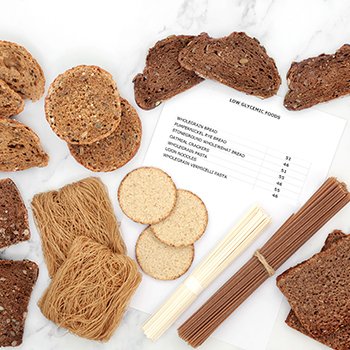ก้าวข้ามความท้าทายในการพัฒนาส่วนผสมอาหารที่มีค่าดัชนีน้ำตาลต่ำ Overcoming the Challenges of Low Glycemic Index Ingredients Development
714 Views |

ก้าวข้ามความท้าทายในการพัฒนาส่วนผสมอาหารที่มีค่าดัชนีน้ำตาลต่ำ Overcoming the Challenges of Low Glycemic Index Ingredients Development
By: วิไลลักษณ์ ชยประเสริฐ
Wilailack Chayaprasert
Food Ingredient Specialist
Pure Chemicals Co., Ltd.
wilailack@purechemicals.com
จุฑาวุฒิ อุชุปัจ
Juthawut U-chupaj
Business Innovation Manager
Pure Chemicals Co., Ltd.
Juthawut@purechemicals.com
ดัชนีน้ำตาล (Glycemic Index; GI) คือ ตัวชี้วัดระดับน้ำตาลในเลือดหลังรับประทานอาหารประเภทคาร์โบไฮเดรต จึงเป็นค่าพารามิเตอร์ที่ถูกพัฒนาเพื่อใช้เป็นแนวทางในการเลือกรับประทานและแนะนำปริมาณการบริโภคอาหารของกลุ่มผู้บริโภคที่มีภาวะโรคเบาหวาน โดยจะพิจารณาจากอาหารที่อาจส่งผลต่อระดับน้ำตาลในเลือด ซึ่งค่า GI ของอาหารจะมีตั้งแต่ 0 ถึง 100 ปัจจุบันมีการใช้ค่าดัชนีน้ำตาลเป็นแนวทางในการวางแผนการบริโภคอาหารแต่ละมื้อ โดยเมนูอาหารที่มีค่า GI ต่ำ จะหมายถึงอาหารที่มีส่วนประกอบของคาร์โบไฮเดรตที่ดูดซึมได้ช้าและใช้เวลานาน ส่วนอาหารที่มีค่า GI สูง จะเป็นอาหารที่มักถูกดูดซึมได้อย่างรวดเร็วในเวลาอันสั้น จากการวิจัยทางคลินิกก็ได้แสดงให้เห็นว่า แม้การรับประทานอาหารที่มีค่า GI ต่ำจะไม่แสดงผลที่ชัดเจนนัก แต่ก็มีส่วนช่วยลดปัจจัยเสี่ยงทางระบบหัวใจและหลอดเลือด ระดับน้ำตาลในเลือด รวมถึงน้ำหนักตัวของผู้ป่วยโรคเบาหวานได้ ผู้ป่วยกลุ่มนี้จึงต้องหลีกเลี่ยงอาหารที่มีค่าดัชนีน้ำตาลสูงเพื่อลดระดับน้ำตาลในเลือดภายหลังการรับประทานอาหาร และควบคุมระดับน้ำตาลในเลือดในระยะยาวอันเป็นปัจจัยเสี่ยงของการเกิดโรคหัวใจและหลอดเลือด
แนวทางการเลือกใช้ส่วนผสมอาหารในการลดค่าดัชนีน้ำตาล
งานวิจัยที่เกี่ยวข้องได้แสดงให้เห็นว่า ส่วนผสมอาหารที่พัฒนาจากแป้ง เช่น พอลิเดกซ์โตรส รีซิสแทนท์เดกซ์ทริน มอลโทเดกซ์ทริน ไอโซมอลโทโอลิโกแซ็กคาไรด์ และแป้งทนต่อการย่อย ถูกนำมาทดสอบคุณสมบัติในการส่งเสริมสุขภาพหลายประการ และได้รับอนุญาตให้มีการกล่าวอ้างทางสุขภาพในหลากหลายผลิตภัณฑ์ รวมถึงกลุ่มของใยอาหาร เช่น เซลลูโลส กัม เบต้า-กลูแคน และไซเลียมฮัสก์ ก็สามารถช่วยลดการตอบสนองต่อระดับน้ำตาลในเลือดอันเป็นผลจากการบริโภคอาหารที่มีสารคาร์โบไฮเดรตสูงได้ นอกจากนี้ ข้อมูลแนะนำโดยสมาคมโรคเบาหวานแห่งสหรัฐอเมริกา (American Diabetes Association; ADA) ยังระบุไว้ว่า การบริโภคใยอาหารที่ละลายน้ำได้ เช่น ไอโซมอลโทเดกซ์ทริน ในปริมาณที่สูงกว่าคำแนะนำสามารถช่วยเพิ่มประสิทธิภาพในการควบคุมระดับน้ำตาลในเลือดได้ ดังนั้น การใช้ส่วนผสมอาหารที่พัฒนาจากแป้งร่วมกับการเติมใยอาหารในผลิตภัณฑ์ จึงเป็นแนวทางที่สามารถนำไปใช้เพื่อลดค่า GI ของผลิตภัณฑ์อาหาร เช่น ขนมอบ ขนมปังกรอบ ซีเรียล บะหมี่กึ่งสำเร็จรูป พาสต้า เครื่องดื่ม ซุป และอื่นๆ ได้ ทั้งยังเป็นแหล่งของพรีไบโอติกส์ที่มีบทบาทสำคัญในการรักษาสมดุลของระบบทางเดินอาหารอีกด้วย
The glycemic index (GI) measures blood sugar levels after eating carbohydrate-containing food. Therefore, it is a parameter developed as a food choice and recommended guide for people with diabetes based on how foods affect blood sugar levels. The GI ranks food on a scale from 0 to 100. Currently, the glycemic index is the main guide for meal planning. A low-GI diet may refer to meals as containing carbohydrates that are absorbed slowly and take a long time, while high-GI diets are usually absorbed quickly over a shorter time. Clinical studies have shown that low GI diet results are not significant but can improve cardiometabolic and blood sugar levels, including body weight, for people with diabetes. Therefore, diabetes patients must avoid high GI foods in order to lower postprandial glycemic excursions and improve longer-term glycemic control, which is one of the cardiometabolic risk factors.
Guidelines for selecting food ingredients to reduce the glycemic index
The related studies shown that starch-derived ingredients (polydextrose, resistant dextrins, maltodextrins, isomalto-oligosaccharides (IMO), and resistant starch) have been heavily investigated for their health benefits, and various health claims were approved promoting their use in various food applications. Additionally, dietary fiber (cellulose, gums, β-glucan, and psyllium husk) can contribute to reducing the glycemic response resulting from the consumption of carbohydrate-rich foods. The Recommendation by the American Diabetes Association (ADA) indicated that higher consumption of water-soluble dietary fiber, such as isomaltodextrin above the level, can enhance glycemic control. Therefore, adding starch-derived ingredients with dietary fiber in recipes is the main strategy that can be used to reduce the GI value of food products such as baking, biscuits, cereal, instant noodles, pasta, beverages, soups, and others. It is also a source of prebiotics that play an important role in maintaining the balance of the digestive system.






